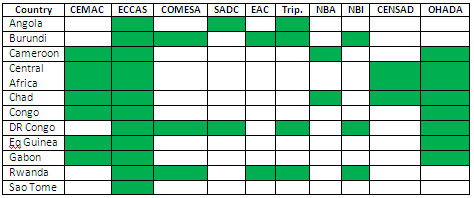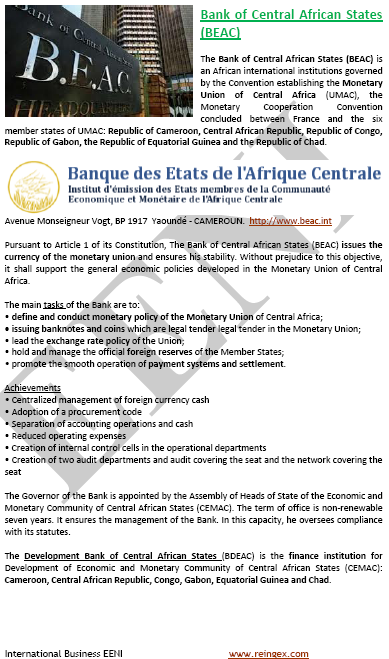Adaptation Central African Students (Bachelor, Trade)
Adaptation of the Bachelor of Science to Central African Students (Bachelor of Science in International Trade, e-learning)
| Bachelor of Science in International Trade |

Subject - “Adaptation of the Bachelor of Science to Central African Students (Study of the main regional economic institutions of the region where the student lives)” (5 ECTS) - Online Bachelor of Science in International Trade (fourth semester).
Subjects for the Central African Students
Proposed subjects for the Central African Students: Angola, Burundi, Cameroon, the Central African Republic, Chad, the Equatorial Guinea, Gabon, the Republic of the Congo, the DR Congo, Rwanda, and São Tomé

- Central African Economic and Monetary Community (CEMAC)
- Economic Community of Central African States (ECCAS)
- Economic Community of the Great Lakes Region
- Bank of Central African States (BEAC)
- Maritime Organization for West and Central Africa
- CEN-SAD
- Southern African Development Community (SADC)
- East African Community (EAC)
- Common Market of Southern Africa and Eastern (COMESA)
- COMESA-EAC-SADC Tripartite FTA
- Niger Basin Authority
- International Conference on the Great Lakes Region
- Organization for the Harmonization of Business Law in Africa (OHADA)
- Nile Basin Initiative
Syllabus of the Program: Central African Economic and Monetary Community (CEMAC).
- Introduction to the Central African Economic and Monetary Community (CEMAC)
- Organization chart of the CEMAC
- CEMAC Regional Economic Programs
- Specialized institutions of the Central African Economic and Monetary Community
- Economic and Monetary Union of Central Africa
- Development Bank of Central African States (BDEAC)
- International Commission on the Congo-Oubangui-Sangha Basin
- Economic outlook of the Central African Countries
- CEMAC Customs
- Customs Tariff of the Central African Economic and Monetary Community
- Customs procedures. Declaration Models
- Sydonia System
Objectives of the Program “Central African Economic and Monetary Community (CEMAC)”:
- To understand the objectives of the Central African Economic and Monetary Community
- To evaluate the advantages for the member countries and the areas of cooperation of the CEMAC
- To analyze the Economic Integration process and International Trade between the member countries of the Central African Economic and Monetary Community
- To understand the Economic and Monetary Union of the CEMAC as well as the customs procedures and the Sydonia System
- To know the Regional Economic Program of the Central African Economic and Monetary Community (creation of an Integrated Economic Area)
- To analyze the role of the affiliated institutions of the CEMAC: BEAC, BDEAC
Bank of Central African States (BEAC).
- Introduction to the Bank of Central African States
- Monetary Policy of the BEAC
- Reform of the Methods of Payment of the CEMAC
- Tele compensation system in Central Africa
Syllabus of the Program: Economic Community of Central African States (ECCAS).
- Introduction to the Economic Community of Central African States
- Structure and specialized agencies of the Economic Community of Central African States
- Areas of intervention of the CEMAC
- Forests Commission of Central Africa
- Regional Commission for Fisheries of the Gulf of Guinea
- Commission of the Central African Forests
- Energetic pool of Central Africa
- Programs of the Economic Community of Central African States
- Integration of Indigenous Peoples
- Responsible Management of Protected Areas
- Sustainable development for integration
- Integration through the agriculture
- Green economic development in Central Africa
Objectives of the Program “Economic Community of Central African States (ECCAS)”:
- To understand the objectives, functions and specialized agencies of the Economic Community of Central African States
- To evaluate the advantages for the member countries of the ECCAS and the areas of cooperation
- To know the socio-economic context and development challenges of the countries of the Central African region
- To analyze the Economic Integration process and International Trade between the member countries of the Economic Community of Central African States
Syllabus of the Program: International Conference on the Great Lakes Region.
- Introduction to the International Conference on the Great Lakes Region
- The main programs of the Conference
- Peace, security, democracy and good government
- Economic development and regional integration
- Northern Corridor
- Trans-African highway (Mombasa-Lagos)
- Lobito Corridor
- South Corridor
- Humanitarian and social issues
- Cross-cutting issues
Objectives of the Program “International Conference on the Great Lakes Region”:
- To understand the objectives and functions of the International Conference on the Great Lakes Region
- To evaluate the advantages for the member countries of the International Conference on the Great Lakes Region and the areas of cooperation
- To analyze the economic development and regional integration
Syllabus of the Program: Niger Basin Authority (ABN)
- Introduction to the Niger Basin Authority
- Agencies of the Niger Basin Authority
- Socio-economic profile of the Niger Basin region
Objectives of the Program “Niger Basin Authority (ABN)”:
- To understand the objectives of the Niger Basin Authority
- To know the socio-economic profile of the Niger Basin region
Syllabus of the Program: Organization for the Harmonization of Business Law in Africa (OHADA).
- Introduction to the Organization for the Harmonization of Business Law in Africa (OHADA)
- OHADA Uniform Acts
- Commercial law in Africa
- Commercial Companies Law
- Law on Guarantees and Bonds
- Cancellation of liabilities in case of insolvency
- Arbitration Law of the Organization for the Harmonization of Business Law in Africa
- Organization and harmonization of corporate accounting
- Contracts of carriage of goods by road
- Cooperatives Law
- Treaty on the Harmonization of the African Business Law
Objectives of the Program “Organization for the Harmonization of Business Law in Africa (OHADA)”:
- To understand the objectives (legal integration) of the Organization for the Harmonization of Business Law in Africa
- To know the OHADA Uniform Acts (commercial law, arbitration, transport...)
- To analyze the implications for business and companies
- To understand the role of the OHADA in African Integration
Syllabus of the Program - G5 Sahel.
- Introduction to G5 Sahel: Burkina Faso, Mali, Mauritania, Niger, and Chad (Africa)
- Threats of jihadist terrorism in the Sahel
- Objectives of the G5 Sahel: fight against jihadist terrorism
- Pilot scheme of the G5 Sahel
- Conference of Heads of State
- Council of Ministers
- Permanent Secretariat
- Partnerships of the G5 Sahel with France, the EU, Japan, the UN
Syllabus of the Program: Community of Sahel-Saharan States (CEN-SAD).
- Introduction to the Community of Sahel-Saharan States (CEN-SAD)
- Member states of the CEN-SAD
- Sahel-Saharan Bank for Investment and Trade
- Regional Food Security Programme
- African Initiative of the Great Green Wall
- Struggle against desertification in the Sahel-Sahara region
Objectives of the Program “Community of Sahel-Saharan States (CEN-SAD)”:
- To understand the objectives of the CEN-SAD
- To evaluate the advantages for the member countries of the Community of Sahel-Saharan States
- To analyze the areas of cooperation and programs of the CEN-SAD
- To know the role of the Sahel-Saharan Bank for Investment and Trade
Syllabus of the Program: Southern African Development Community (SADC).
- Introduction to the Southern African Development Community (SADC)
- The main institutions of the Southern African Development Community
- History of the SADC
- SADC Treaty
- Economic profile of the region of the SADC
- SADC Strategic plans
- Economic development in Southern Africa
- International Trade in the region of the Southern African Development Community
a- Trade liberalization
b- Customs and trade facilitation
c- Competition Policy
d- Non-tariff and Technical Barriers to Trade
e- Trade in services
f- Trade Development Program of the SADC - Regional Indicative Strategic Development Plan
- Directorate of Trade, Industry, Finance and Investments
- Integration Process in the Southern African Development Community
a- SADC Free-trade area
b- Customs Union
c- Common Market
d- Economic and Monetary Union
e- Single Currency - Support Program for the SADC Regional Economic Integration
- Infrastructures and services in the region of the SADC
- Transport in the SADC region
a- Maritime transport, ports and waterways - ICT and telecommunications
- Tourism
- Food, agriculture and natural resources
- Southern Africa Trade Hub
- Protocol against corruption of the SADC
- Trade Agreements of the SADC
Objectives of the Program “Southern African Development Community (SADC)”:
- To understand the objectives and the affiliated institutions of the Southern African Development Community
- To evaluate the advantages for the member countries of the SADC and the areas of cooperation
- To analyze the Economic Integration process: the free-trade area of the SADC, Customs Union, Common Market, Economic and Monetary Union and the single currency
- To analyze the intra-SADC Trade
- To know the Regional Indicative Strategic Development Plan of the SADC
- To explore free trade agreements of the SADC
Syllabus of the Program: Common Market for Eastern and Southern Africa (COMESA).
- Introduction to Common Market for Eastern and Southern Africa (COMESA)
- Decision Making of the COMESA
- COMESA Integration Process;
- COMESA Free-trade
- COMESA Customs
- COMESA Common Market
- COMESA Economic Community
- Trade facilitation in the Common Market for Eastern and Southern Africa
- Simplified cross-border procedures for small companies
- Non-tariff barriers elimination
- Economy of the COMESA region.
- International Trade of the COMESA
- Intra-COMESA Trade
- Trade in services
- Investments in the COMESA region
- Industry
- Energy
- Agriculture of the region of the Common Market for Eastern and Southern Africa
- Comprehensive Africa Agriculture Development Programme
- Alliance for Commodity Trade in Eastern and Southern Africa
- Harmonization Program of Sanitary and Phytosanitary Measures (SPS)
- Infrastructures in the COMESA region.
- Transport facilitation
- Information and communication technologies
- Institutions and Agencies of the COMESA
- COMESA Reinsurance Company
- COMESA Regional Investment Agency
- African Trade Insurance Agency
- Federation of National Associations of Women in Business of the COMESA
- COMESA Entrepreneurs Council
Objectives of the Program “Common Market for Eastern and Southern Africa (COMESA)”:
- To understand the objectives, functions and institutions of the COMESA
- To know the economy of the COMESA region
- To analyze the COMESA Integration Process: the free-trade area, the Customs Union, the Common Market and the Economic Community COMESA
- To evaluate the advantages for the member countries of the COMESA
- To know the COMESA trade and transport facilitation programs
- To analyze the role of the affiliated institutions: Bank of the ZEP, AIRC, COMESA Reinsurance Company, ACA
United States-COMESA Trade and Investment Framework Agreement.
- The U.S.-COMESA countries (Common Market for Eastern and Southern Africa) Trade and Investment Framework Agreement (TIF)
- International Trade between the U.S. and the countries of the COMESA
- Advantages of the U.S.-COMESA Trade and Investment Framework Agreement
Syllabus of the Program: COMESA-EAC-SADC Tripartite Free Trade Agreement.
- Introduction to the COMESA-EAC-SADC Tripartite FTA
- Institutional framework
- Areas of intervention
- Tripartite free-trade area
- Trade facilitation and Transport
- Infrastructure Development
- Mechanisms related to trade
- Corridors and infrastructures of the COMESA region-SADC-EAC
- towards the African Continental Free-Trade Area
Objectives of the Program “COMESA-EAC-SADC Tripartite Free Trade Agreement”:
- To understand the objectives (Customs Union) and the areas of cooperation of the COMESA-EAC-SADC Tripartite FTA
- To evaluate the advantages for the member countries of the tripartite
- To understand the advantages of the Tripartite free-trade area
- To analyze the Tripartite programs: trade facilitation, transportation, and non-tariff barriers elimination
- To understand the Tripartite Agreement as a stage towards the African Continental Free-Trade Area
Syllabus of the Program: East African Community (EAC).
- Introduction to the East African Community (EAC)
- Trade Regime of the East African Community
- Agencies of the Community
- Structure and functions of the Secretary of the East African Community
- Creation of the EAC Customs Union
- Creation of the EAC Common Market
- Monetary and financial cooperation
- Treaty for the establishment of the East African Community
- East African Development Bank
Objectives of the Program “East African Community (EAC)”:
- To understand the objectives and functions of the East African Community
- To evaluate the advantages for the member countries and the areas of cooperation of the East African Community
- To analyze the Economic Integration process (Customs Union and Common Market) and International Trade between the member countries of the East African Community
- To know the role of the East African Development Bank
East African Community (EAC)-United States Trade and Investment Partnership Agreement.
- Introduction to the Trade and Investment Partnership Agreements between the East African Community (EAC) and the U.S.
- Objectives of the Association Agreement
- International Trade between the countries of the EAC and the U.S.
Syllabus of the Program: Economic Community of the Great Lakes Region (CEPGL).
- Introduction to the Economic Community of the Great Lakes Region (CEPGL)
- Agencies of the Economic Community
- International Society of Energy of the countries of the Great Lakes: Burundi, the DR Congo, Rwanda
- Regional Economic Program 2014-2020
- Economic Integration, Investments, International Trade, and Promotion
- Private Sector Forum of the Economic Community
- Northern Corridor
Syllabus of the Program: Nile Basin Initiative (NBI)
- Introduction to the Nile Basin Initiative (NBI)
- Economic profile of the Nile Basin
- Advantages for Burundi, the DR Congo, Egypt, Ethiopia, Kenya, Rwanda, South Sudan, Sudan, Tanzania, and Uganda
- Structure of the Nile Basin Initiative
- Plans and strategic projects of the Nile Basin Initiative
Samples: adaptation of the Bachelor of Science to Central African Students (Study of the main regional economic institutions of the region where the student lives) (Bachelor of Science in International Trade, e-learning, fourth semester).




Language of the subject “adaptation of the Bachelor of Science to Central African Students (Study of the main regional economic institutions of the region where the student lives)” of the Bachelor of Science in International Trade (fourth semester):  or or
or or  EENI
EENI  EENI
EENI  EENI.
EENI.
(c) EENI Global Business School (1995-2024)
We do not use cookies
Top of this page

